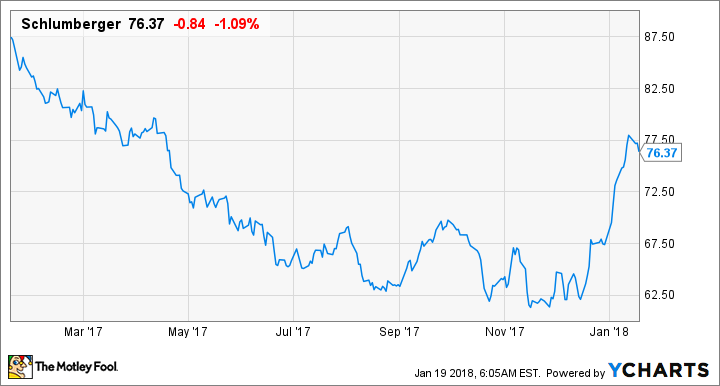Schlumberger's Operating Earnings Improve Despite One-Time Charges
This past quarter was yet another example of why investors shouldn't expect industry cycles to follow a straight path either up or down. While Schlumberger (NYSE: SLB) posted better revenue and operating numbers for the fourth quarter, bottom-line results were hit yet again by a large swath of charges that swung the company back to the loss column.
It may have been discouraging, but the underlying business and management's outlook for 2018 should reassure investors that their investment in Schlumberger is well placed. Let's dig into the oil services giant's most recent results and see what it anticipates for the rest of the year.

Image source: Getty Images.
By the numbers
Metric | Q4 2017 | Q3 2017 | Q4 2016 |
|---|---|---|---|
Revenue | $8.18 billion | $7.91 billion | $7.1 billion |
Pre-tax income | ($2.21 billion) | $667 million | ($213 million) |
EPS | ($1.63) | $0.39 | ($0.15) |
Free cash flow | $456 million | $1.1 billion | $1.1 billion |
Data source: Schlumberger earnings release. EPS = earnings per share.
Something funky has been going on in Schlumberger's earnings lately. Although the company posted impressive revenue and operating income gains, there were all completely wiped out by charges and writedowns. This quarter, the largest of those writedowns were related to its exiting a land and marine seismic data acquisition business and writing down the full value of its business in Venezuela because of deteriorating economic and political developments. In total, Schlumberger took $3.04 billion in charges to the income statement.
While these are typically one-time, noncash charges that investors need not worry about, it's somewhat concerning that Schlumberger has been taking these large writedowns on a regular basis recently. Hopefully, this time around was an instance of "ripping off the bandage" and we won't see many more of these charges for a while.
From an operations standpoint, though, the business has stayed on the same course that we've seen for some time. Revenue in North America continues to grow at a double-digit pace, and margins there are recovering nicely. Conversely, its international business remains stuck in the mud as North American shale keeps taking market share in oil production. Schlumberger's business is gaining some traction in Latin America, however, as shale drilling in Argentina looks poised to start taking off soon.
Each of Schlumberger's business segments performed well from an operations perspective. Revenue grew in every business segment with the exception of reservoir characterization, but that segment made up for it with much higher margins this past quarter. Schlumberger and other oil services companies have a lot of fixed costs related to equipment. When more equipment gets used, margins improve quickly.

Data source: Schlumberger earnings release. Chart by author.
Perhaps the only discouraging aspect of this past quarter was the lack of free cash flow compared to prior quarters. However, it closed on a deal to buy Weatherford International's (NYSE: WFT) hydraulic fracturing business for $430 million in cash this past quarter and invested an extraordinary amount into its production management business. Without that purchase, the company's free cash flow would have been more in line with prior quarters.
What management had to say
You can always count on CEO Paal Kibsgaard to give a well thought out and detailed description of what he foresees in the oil market. His statement in the earnings release gave a rather positive outlook for the industry in 2018, which is a bit of a reversal for him as he has been one of the more pessimistic voices out there in recent years.
Looking at the oil market, the strong growth in demand is projected to continue in 2018, on the back of a robust global economy. On the supply side, the extension of the OPEC- and Russia-led production cuts is already translating into higher-than-expected inventory draws.
In North America, 2018 shale oil production is set for another year of strong growth, as the positive oil market sentiments will likely increase both investment appetite and availability of financing. At the same time, the production base in the rest of the world is showing fatigue after three years of unprecedented underinvestment. The underlying signs of weakness will likely become more evident in the coming year, as the production additions from investments made in the previous upcycle start to noticeably fall off.
All together this means the oil market is now in balance and the previous oversupply discount is gradually being replaced by a market tightness premium, which makes us increasingly positive on the global outlook for our business.
These positive oil market sentiments are reflected in the third-party E&P spend surveys, which predict 15–20% growth in North American investments in 2018, while the international market is expected to grow for the first time in four years, with a projected 5% increase in spend.
What a Fool believes
Despite the discouraging net income, investors should be buoyed by what's going on at Schlumberger these days. By acquiring Weatherford's hydraulic fracturing equipment, it helps to solidify a part of the business that has historically been weak compared to its largest rival, Halliburton. Revenue continues to grow at a decent clip, and margins are expanding back to levels we saw before the oil price crash. These elements, plus higher oil prices, suggest that the coming year could result in a strong recovery for Schlumberger.
Watch for continuing writedowns and charges, though. Management has had a few years to reassess the value of its assets and determine the appropriate size going forward. If we keep seeing writedowns for poorly performing businesses or for more restructuring, investors may need to start asking why.
More From The Motley Fool
Tyler Crowe has no position in any of the stocks mentioned. The Motley Fool has no position in any of the stocks mentioned. The Motley Fool has a disclosure policy.

 Yahoo Finance
Yahoo Finance 